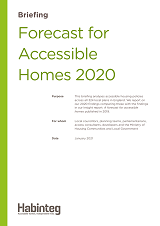A Forecast for accessible homes 2020

This briefing by Habinteg Housing Association reveals that over half of English local housing policies still failing disabled & older people.
Its latest research shows that, in the next 10 years, 70% of all new homes will still not have to meet any accessible housing standard.
The updated analysis of 324 English 'local plans' shows the proportion of new homes to be built by 2030 to accessible standards fell from 34.4% in the 2019 analysis to 31.5% in the 2020 update. Moreover, the proportion specified under the older Lifetime Homes standard has halved from 12% in 2019 to 6% in 2020.
The new data also reveals that:
- 52.5% of local authorities are still failing to set requirements for accessible housing standards for new homes. This is despite Government's National Planning Policy Framework and Guidance (opens new window), which requires local planning authorities to set out such policies using the Building Regulations Optional Standards.
- The proportion of homes due to be suitable for wheelchair users has stayed broadly similar with the picture outside London improving by 0.5% to reach 1.5% of all homes planned over the next decade.
- Outside London, a total of 19% (362,312) of new homes are planned to meet the accessible and adaptable standard by 2030, a rise since the 2019 report (14% /289,616).
- However, taking England as a whole, the proportion of all homes specified to accessible and adaptable or Lifetime Homes standard fell from 32% (776,608) in the 2019 analysis to 29% (671,381) in 2020.
- While the South East now includes 15 additional plans specifying use of the Building Regulations Optional Standards, in the West Midlands no local plans specify these standards for new homes to be built between 2020 and 2030, and the region still has no planning requirement to build any homes suitable for wheelchair users.
Habinteg, along with the Housing LIN, is a founder of the HoME Coalition, and we are calling on the Government to establish the M4(2) accessible and adaptable standard - as the new regulatory baseline following the recent consultation on raising accessibility standards for new homes, with the additional requirement to supply a proportion of homes meeting wheelchair user dwelling standard.
